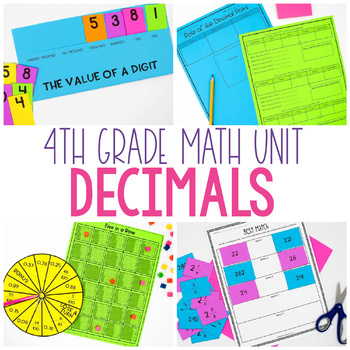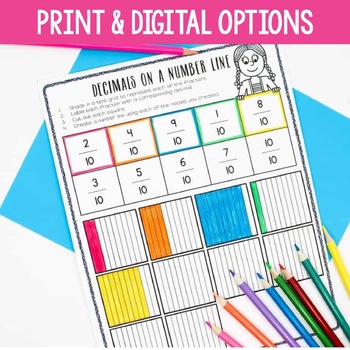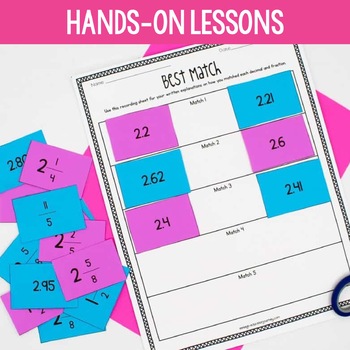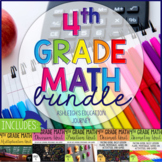4th Grade Decimals | Comparing Decimals | Relate Decimals to Fractions
Ashleigh
54.7k Followers
Resource Type
Standards
CCSS4.NF.C.5
CCSS4.NF.C.6
CCSS4.NF.C.7
Formats Included
- PDF
- Google Apps™
Pages
100 pages
Ashleigh
54.7k Followers

Includes Google Apps™
The Teacher-Author indicated this resource includes assets from Google Workspace (e.g. docs, slides, etc.).
What educators are saying
This was a great unit instead of our math curriculum. It was much more friendly to the students and easy to teach/implement!
This is an excellent resource that engages students in learning about fractions and decimals with minimal prep work for the teacher. Thank you!
Also included in
- This 4th Grade Math Bundle is a year long resource for conceptual math instruction in math workshop, guided math, or any math class. There are eight units that are each centered around a different mathematical concept: 1. Place Value and Rounding; 2. Addition and Subtraction; 3. Multiplication; 4. DPrice $65.70Original Price $73.00Save $7.30
Description
Help your students to develop a conceptual understanding of decimals with this all-inclusive decimal unit! With this resource, students understand how decimals relate to fractions, work with decimal models, forms of decimals, decimals on a number line, as well as how to compare decimals.
This includes four weeks of math instruction that is written in an easy to follow format. The decimal lessons are written to give students a solid foundation of decimals through engaging and hands-on lessons. In this unit you will find performance tasks, as well as optional activities for math centers, and games for review.
What's Included?
- Unit at a Glance
- 20 Lesson Plans that include performance tasks
- 20 Skill Building Worksheets
- Answer Keys
Decimal Lessons
- Reviewing Place Value 10 to 1 Relationship
- Role of the Decimal Point
- Fractions to Decimals
- Four in a Row
- Decimals to Fractions
- Fractions to Decimals
- Fractions to Decimals Continued
- Estimating With a Hundredth Disc
- Decimals on a Number Line
- Friendly Fractions
- Drawing Decimals
- Best Match
- Comparing Decimals With Models
- Line Up the Decimals
- Comparing Decimals With Models
- Nice Numbers
- Decimal War
- Decimal Pictures
- Ordering Decimals
- Decimal Models
- Decimal Scavenger Hunt
- Dog Sitting Services
- Decimal Match
- Decimal Problem Solving
Check out these other 4th Grade Math Units!
- Unit 1 Place Value and Rounding Unit
- Unit 2 Addition and Subtraction Unit
- Unit 3 Multiplication Unit
- Unit 4 Division Unit
- Unit 5 Fraction Unit
- Unit 6 Decimal Unit
- Unit 7 Geometry Unit
- Unit 8 Measurement Unit
Standards Taught
- 4.NF.5. Express a fraction with denominator 10 as an equivalent fraction with denominator 100, and use this technique to add two fractions with respective denominators 10 and 100.4 For example, express 3/10 as 30/100, and add 3/10 + 4/100 = 34/100.
- 4.NF.6. Use decimal notation for fractions with denominators 10 or 100. For example, rewrite 0.62 as 62/100; describe a length as 0.62 meters; locate 0.62 on a number line diagram.
- 4.NF.7. Compare two decimals to hundredths by reasoning about their size. Recognize that comparisons are valid only when the two decimals refer to the same whole. Record the results of comparisons with the symbols >, =, or <, and justify the conclusions, e.g., by using a visual model.
Lesson Plan Includes:
- standard
- materials
- mini lesson
- work time
- closing
- intervention
- extension
- essential questions
- formative assessments
Total Pages
100 pages
Answer Key
Included
Teaching Duration
1 month
Report this resource to TPT
Reported resources will be reviewed by our team. Report this resource to let us know if this resource violates TPT’s content guidelines.
Standards
to see state-specific standards (only available in the US).
CCSS4.NF.C.5
Express a fraction with denominator 10 as an equivalent fraction with denominator 100, and use this technique to add two fractions with respective denominators 10 and 100. For example, express 3/10 as 30/100, and add 3/10 + 4/100 = 34/100.
CCSS4.NF.C.6
Use decimal notation for fractions with denominators 10 or 100. For example, rewrite 0.62 as 62/100; describe a length as 0.62 meters; locate 0.62 on a number line diagram.
CCSS4.NF.C.7
Compare two decimals to hundredths by reasoning about their size. Recognize that comparisons are valid only when the two decimals refer to the same whole. Record the results of comparisons with the symbols >, =, or <, and justify the conclusions, e.g., by using a visual model.






